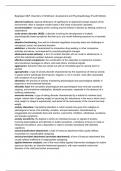Begrippen D&P, Disorders of Childhood: development and Psychopathology (Fourth Edition)
aberrant salience: atypical attributions of significance to objectively benign aspects of the
environment; often a symptom evident early in the onset of psychotic disorders.
accommodation: managing and/or working around children’s distress by altering routines or
expectations
acute stress disorder (ASD): a disorder involving the development of multiple
psychologically based symptoms that last up to one month following exposure to a traumatic
event
adaptive functioning: how well an individual negotiates everyday tasks and challenges in
conceptual, social, and practical domains
addiction: a disorder characterized by compulsive drug seeking or other compulsive
activities and abuse, accompanied by neurophysiological changes
adolescent-onset pathway: a form of conduct disorder with an onset in adolescence, in
which the individual’s problem behavior emerges abruptly
affective social competence: the coordination of the capacities to experience emotion,
send emotional messages to others, and read others’ emotional signals
aggression: behaviors that are carried out with an immediate goal of causing harm to
another
agoraphobia: a type of anxiety disorder characterized by the experience of intense anxiety
in places where individuals feel insecure, trapped, or not in control, most often associated
with avoidance of such places
allostasis: the process of actively maintaining physiological and psychological stability in
response to environmental demands
allostatic load: the cumulative physiological and psychological wear and tear caused by
ongoing, and sometimes maladaptive, allostatic processes, especially in the absence of a
buffering relationship
anorexia nervosa: a type of eating disorder characterized by a refusal to maintain body
weight, intense fear of gaining weight or becoming fat, disturbance in the way in which one’s
body weight or shape is experienced, and denial of the seriousness of the current low body
weight
anxiety disorders: internalizing disorders in which anxiety has gone from adaptive to
pathological in terms of its intensity, duration, and pervasiveness; characterized by
exaggerated and unrealistic fears and worries, overcontrol, inhibition, withdrawal, avoidance,
and somatic symptoms
anxiety sensitivity: the degree to which an individual focuses on signals of anxiety;
involving hypervigilance and attention to bodily sensations, a tendency to focus on weak or
infrequent sensations, and a disposition to react to somatic sensations with distorted
cognitions
anxious/ambivalent attachment: a type of insecure attachment that usually reflects
inconsistent or unpredictable caregiving
anxious/avoidant attachment (avoidant attachment): a form of insecure attachment that
usually reflects ineffective or inappropriate caregiving
applied behavior analysis: one of the most widely applied intervention strategies for autism
spectrum disorder; an intensive behavioral approach, with near-constant control and
direction of the child and his/her environment
, assessment: the systematic collection of relevant information in order to both differentiate
everyday or transient difficulties from clinically significant psychopathology and classify a
child’s particular disorders
attention deficit hyperactivity disorder (ADHD): a disorder characterized by a
combination of impulsivity, hyperactivity, and inattentiveness
atypical anorexia nervosa: a form of anorexia in which individuals meet the diagnostic
criteria for restricted eating observed for anorexia nervosa except that their weight is within
or above the normal range
autism spectrum disorder (ASD): a broadly conceptualized category of disorder reflecting
compromised development in social functioning and communication, as well as restricted
patterns of activities or interests
avoidant/restrictive food intake disorder (ARFID): an eating disturbance involving the
lack of interest in, or avoidance of, food leading to significant weight loss, nutritional
deficiencies, and/or impaired psychosocial functioning
barriers to care: factors that impede access to mental health services, including structural
barriers such as lack of provider availability, inconveniently located services, transportation
difficulties, inability to pay, inadequate insurance coverage, or both; individual barriers such
as denial of problems or lack of trust in the system; and sociocultural barriers such as the
stigma of psychopathology or mental illness
behavior genetics: the study of the joint effects of genes and environments
behavioral addictive disorders: problematic internet use, gaming, and gambling, leading to
loss of behavioral control
behavioral models: psychological models that emphasize the individual’s observable
behavior within a specific environment
binge drinking: heavy consumption of alcohol in a relatively short period of time, with the
primary intention of becoming intoxicated
binge eating disorder: a disorder characterized by repeated episodes of binge eating, a
sense of lack of control, and significant distress
bipolar disorders: a mood disorder characterized by alternating periods of depression and
mania, or hypomania
birth cohort: individuals born in a particular historical period who share key experiences
and events
body dissatisfaction: the degree to which a person is concerned or displeased with his or
her physical appearance
body esteem: the degree to which individuals accept or are pleased with their physical
appearance
body image: a person’s perception of his or her own physical appearance
broad (or broader) autism phenotype: subclinical symptoms of autism displayed by family
members of people with autism
bulimia nervosa: a type of eating disorder characterized by recurrent episodes of being
eating, a sense of lack of control over eating during the episode, and recurrent inappropriate
compensatory behavior in order to prevent weight gain, such as self-induced vomiting,
misuse of laxatives, diuretics, enemas, or other medications; fasting; or excessive exercise.
Self-evaluation is unduly influenced by body shape and weight
bullying: the intentional infliction of physical or emotional harm through physical aggression,
harassment, intimidation, teasing, or psychological coercion






